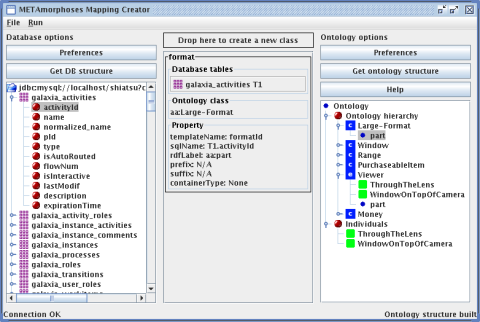
To make the schema mapping easier, there is the drag'n'drop GUI editor for creating mapping documents (see the picture).
The editor connects a specified database and provides its structure in its left window. An ontology can be viewed in the right window. The whole application is designed to use Drag'n'drop concept. Schema concepts from both sides can be dragged to the center, where a visual representation of a mapping document is built and editor asks for values of mandatory fields. This mapping document can be saved in XML format and used directly in the METAmorphoses processor.
The mapping editor is written in Java programming language to provide platform independent software. It uses JDBC drivers for database connectivity and Jena2 RDF API \cite{jena} to handle ontologies.
METAmorphoses mapping and data trasformation cover:
The main limitation of the application is that it can load only one ontology file at a time. If more ontologies would be mapped, they had to be merged to one file. This is possible subject for the future work on this tool.
The application is implemented by Jiøí Hofman, a student of Faculty of Nuclear Sciences and Physical Engineering at CTU in Prague.
The project is being developed under Lesser GPL licence.
This is the short clarification of the licence:
METAmorphoses is Free Software. The LGPL license is sufficiently flexible to allow the use of METAmorphoses in both open source and commercial projects. Using METAmorphoses (by importing METAmorphoses's public interfaces in your Java code), and extending METAmorphoses (by subclassing) are considered by the authors of METAmorphoses to be dynamic linking. Hence our interpretation of the LGPL is that the use of the unmodified METAmorphoses source or binary, or the rebundling of unmodified METAmorphoses classes into your program's .jar file, does not affect the license of your application code.
If you modify METAmorphoses and redistribute your modifications, the LGPL applies.